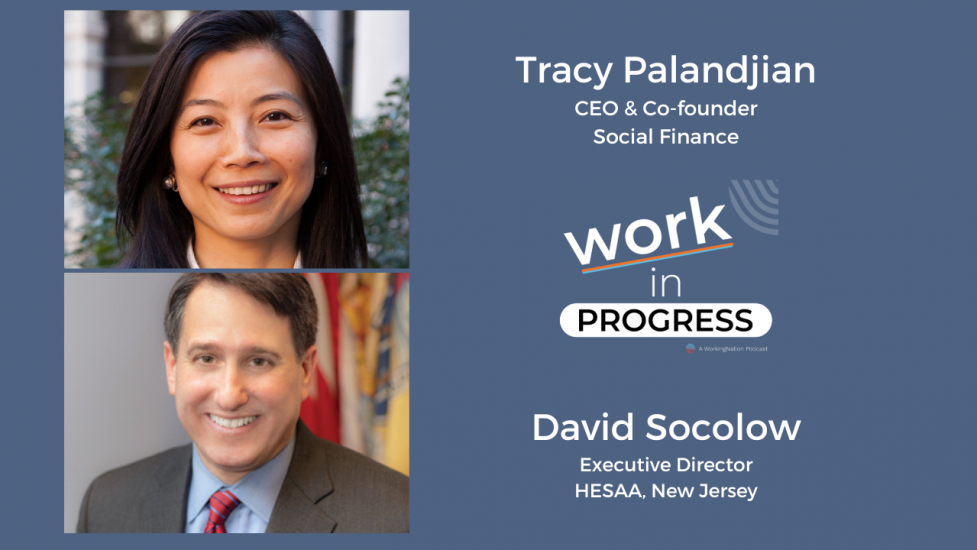

Workforce & Education Investments, Workforce & Economic Mobility, Financing Tuition & Living Expenses
Stephanie Reyes had a hard time finding steady work in Bakersfield, California, where she lived with her young son. Then one day, she saw an advertisement on YouTube for American Diesel Training Centers (ADTC). She registered for a five-week diesel technician training course with no upfront tuition cost. A few months later, Stephanie landed a job at a national transportation company.
“As a result of this training, I now have a steady job that will lead to bigger things,” she said. “I’m so proud, because it’s not just a job—it’s a career that I can use to look after myself and my son.”
Watch Stephanie’s story →
We developed and launched the Career Impact Bond in 2019 with the $50 million UP Fund to make stories like Stephanie’s a reality. The Career Impact Bond is a holistic model for financing education and training to help unemployed and underemployed people participate in the modern economy. Learners access quality job training, receive supportive services such as career coaching and living stipends, and land in-demand jobs, all without taking on the level of financial risk that typically comes with traditional workforce training or college degree programs.
The Career Impact Bond has served as the engine for six different partnerships and counting, including our work with ADTC.
Earlier this month, MDRC, a policy research and evaluation organization, published the first independent assessment of the Career Impact Bond. The research, which was drafted with funding from Strada Education Network, draws on a wealth of quantitative and qualitative data to understand the learner experience, focusing on early iterations of the model that used income-share agreements (ISAs) through the UP Fund. We’ve since expanded beyond ISAs and embraced new financial tools such as outcomes-based loans, a shift discussed below.
MDRC’s findings recognize the benefits of this approach while offering important design lessons as we and others explore new ways to improve economic mobility at scale. Over the last several years, we’ve learned a lot, most notably:
There is strong demand for the Career Impact Bond
Participating training providers scaled their operations to serve applicants looking for more accessible financing to support their career aspirations. More than 2,200 learners have enrolled with training providers with financing from the UP Fund. For example, Clinical Research Fastrack, which trains clinical research professionals, was able to expand its training services and support to a larger number of immigrants and refugees—learners who cannot typically access or afford traditional financing and therefore often go underserved within the workforce training ecosystem.
Result: Over time, we have expanded and evolved our workforce financing vehicles to include place-based recyclable loan funds, known as Pay It Forward Funds, and other corporate and philanthropic outcomes-based funds such as the Google Career Certificates Fund.
Limited training providers can participate in the original Career Impact Bond model
Through the UP Fund, we engaged around 100 training providers, conducted thorough due diligence on 17, and structured Career Impact Bonds with six who met our financing criteria. This process revealed that many training providers do not meet the required launch criteria, which includes:
- A demonstrated history of strong learner outcomes and capacity to track detailed performance data going forward
- The presence of a defined financing gap for learners
- The ability or willingness to link tuition income to learner program completion and job placement
These requirements make it difficult for some essential training providers, including community colleges, nonprofits, and smaller organizations, to participate in Career Impact Bonds.
Result: We have adjusted Career Impact Bond parameters to allow for different design set-ups. This has included structuring employer- and training provider-repayment models and providing variable advance rates to training providers depending on performance. And in the New Jersey Pay It Forward Program, we work with three local community colleges.
The current marketplace for ISA servicers is small
The market for ISA origination and servicing has changed substantially over the last several years. What was initially seen as a growth opportunity for ISA servicers, is now viewed more skeptically and with more regulatory risk. As states and the federal government have begun to regulate ISAs similar to loans, which will hopefully provide more protections to learners taking out ISAs, several servicers have exited the market altogether. Those that remain are working to mature their business model as the market evolves.
Result: We have worked to streamline the complexity of the earlier ISAs to create a product that is more portable across different workforce financing initiatives. This has included expanding beyond ISAs to outcomes-based loans that resemble a traditional loan with flat repayments above a certain earnings threshold.
Improving learner compliance rates with their financing agreement has been difficult
We were overly optimistic about the share of learners who would be fully compliant with their repayment obligations. This is a multidimensional challenge tied to several variables, including the complexity of the financial instrument, the accessibility and reliability of ISA servicers, the financial circumstances of learners, and the penalties for noncompliance.
Result: We have made multiple adjustments to product design throughout our talent finance portfolio to support improved repayment compliance. This has included calculating advance rates to training providers based on contract compliance of enrolled learners, structuring repayment models directly with training providers or employers, and providing autopay options and other incentives to encourage learner repayment.
Plugging data gaps on employment and earnings outcomes is a challenge
As with many stakeholders in the workforce development ecosystem, we have focused on collecting and analyzing economic outcomes, but struggled to receive complete, accurate, and timely data. We have successfully worked with our training partners to improve self-reported job placement and earnings data. Such data provides a good snapshot of post-program outcomes, but we are still missing information for some learners who do not self report. Servicer data would provide more reliable and longitudinal information on learner career growth and trajectory, but lower than expected compliance rates limit the quality and completeness of that data set.
Result: We have been advocating for policy changes at the federal level to improve administrative data sharing of aggregated earnings and employment data. Our engagement with MDRC has supported additional primary data collection and we have also explored partnerships at the state level to access administrative records for place-based workforce investment funds.
Addressing learner financing is only one piece of the challenge to improve economic mobility and opportunity
Our work with the Career Impact Bond seeks to address barriers to economic mobility but we operate in a system where other barriers persist. While providing more affordable and accessible financing for learners with limited means helps solve a visible barrier to upskilling, there are more difficult barriers that persist. These include improving job-matching for program graduates, elevating recognition of skills and certificates from non-credentialed programs and fostering connections and feedback loops between employers and training providers.
Result: We have piloted a variety of interventions to provide more comprehensive career coaching and soft skills training for learners. Most critically, we have been leaning into employer-connected training models, such as apprenticeships or externships, to create a direct connection between training and employment and allow learners the opportunity to take the skills they learned in the classroom and apply them in an employer setting.
As our work grows and evolves, we will continue to share what we learn to improve workforce training access and expand economic mobility. MDRC will publish an independent final research report on our early Career Impact Bonds financed through the UP Fund at the end of 2024.
Learn more about our economic mobility and workforce efforts →
Related Insight

Social Finance in The New York Times: Job Training That’s Free Until You’re Hired Is a Blueprint for Biden
This feature in the New York Times covers Social Finance’s Career Impact Bond with American Diesel Training Centers. The article highlights two program graduates, Bill and Jordan, who completed the program, found jobs, and are…

WorkingNation Podcast: New Jersey Bets on Zero-Interest, No-Fee Workforce Training Loans
Ramona Schindelheim, editor-in-chief of WorkingNation, sits down with David Socolow and Tracy Palandjian to discuss the New Jersey Pay It Forward Program.